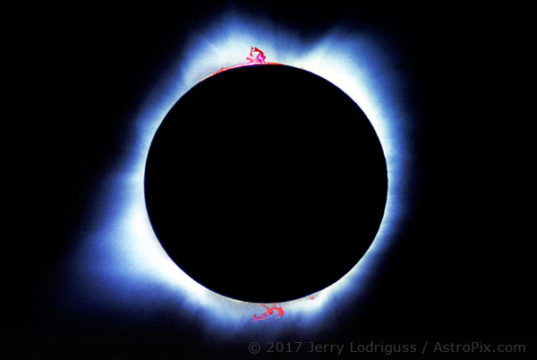Lots of folks are getting ready for what should be one of the most memorable astronomical experiences of their lifetimes — the total solar eclipse of August 21st. Seasoned eclipse chasers have described the view of the ethereal delicate solar corona surrounding the black hole caused by the Moon as “The Eye of God.”

If this is your first total eclipse, here is my advice and the advice of countless experienced eclipse photographers: Don’t even try to take pictures. To paraphrase Nike, “Just don’t do it.” Experience it. That recommendation may be surprising considering this is a column about astrophotography, but trust me — you won’t regret it.
Imagine you spend the brief minutes of totality trying to take pictures of the eclipse. You’ll be looking down at your camera, fiddling with the settings, changing exposures, trying to keep the Sun centered in the frame. The most magnificent spectacle in all of nature will be going on above you, and you won’t even be looking at it! If you’re pictures don’t turn out, you’ll have nothing but regret. But if you just watch the eclipse, you will always have that memory of a special experience.
Synthetic experience is no substitute for reality. People go to a music concert or ball game and watch it on their phones. Throughout my career as a professional sports photographer, I can’t tell you the number of times that I shot a game, concentrating so intensely on my work that, when the game was over, I couldn’t even tell you who won.
In 1991, I photographed the total solar eclipse that lasted 6 minutes and 52 seconds at my observing location in Baja Mexico. I spent that time manually shooting individual exposures on three cameras with three separate scopes and even changing film — and boom! It was over. I don’t feel like I actually saw it at all. I won’t make that same mistake this time.
So put down that camera and experience the real thing! A picture of the eclipse, no matter how good, simply can never replace a once-in-a-lifetime memory.
If this isn't your first eclipse and you do intend to photograph it, I have some tips here.
Good luck, and clear skies!
 1
1
Comments
July 7, 2017 at 5:54 pm
Good article and excellent advice. I was in San Jose del Cabo for the 1991 event as well. I shot 24 bracketed exposures up and down over 12 stops. I got excellent images that went down the drain in processing. The lab ran B&W chemistry on my slide film. Only magenta remained. The bracketed images appeared to be perfect, but useless. I still got to watch for over 4 minutes, but, when it's gone, it's gone and it happens abruptly. This time, there is no time to waste. I have a strategy that will consume only 15 seconds. I can use the Custom settings on my shutter dial to set up 9 bracketed exposures, 3 at each setting. But watching it is much more important. An eclipse is not static. It's dynamic. I've always told people that a picture of an eclipse resembles the eclipse as much as a picture of a waterfall resembles an actual waterfall.
Scott Fuller
You must be logged in to post a comment.
You must be logged in to post a comment.